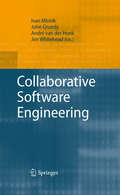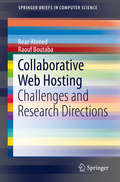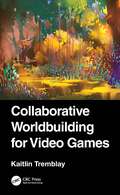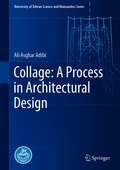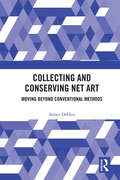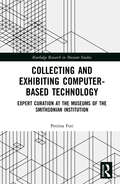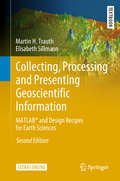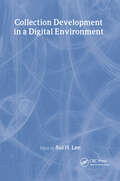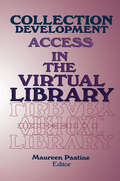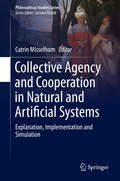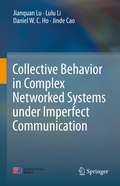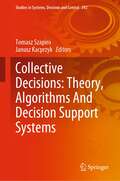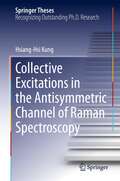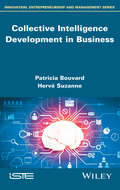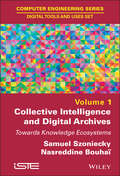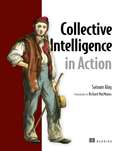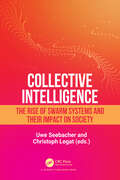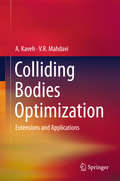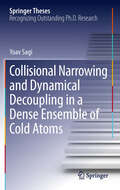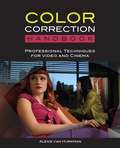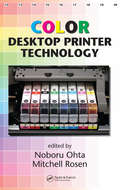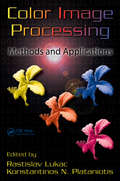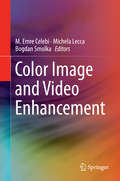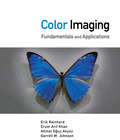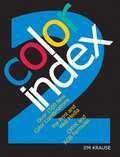- Table View
- List View
Collaborative Software Engineering
by John Grundy Jim Whitehead André Van Hoek Ivan MistríkCollaboration among individuals - from users to developers - is central to modern software engineering. It takes many forms: joint activity to solve common problems, negotiation to resolve conflicts, creation of shared definitions, and both social and technical perspectives impacting all software development activity. The difficulties of collaboration are also well documented. The grand challenge is not only to ensure that developers in a team deliver effectively as individuals, but that the whole team delivers more than just the sum of its parts. The editors of this book have assembled an impressive selection of authors, who have contributed to an authoritative body of work tackling a wide range of issues in the field of collaborative software engineering. The resulting volume is divided into four parts, preceded by a general editorial chapter providing a more detailed review of the domain of collaborative software engineering. Part 1 is on "Characterizing Collaborative Software Engineering", Part 2 examines various "Tools and Techniques", Part 3 addresses organizational issues, and finally Part 4 contains four examples of "Emerging Issues in Collaborative Software Engineering". As a result, this book delivers a comprehensive state-of-the-art overview and empirical results for researchers in academia and industry in areas like software process management, empirical software engineering, and global software development. Practitioners working in this area will also appreciate the detailed descriptions and reports which can often be used as guidelines to improve their daily work.
Collaborative Web Hosting: Challenges and Research Directions (SpringerBriefs in Computer Science)
by Raouf Boutaba Reaz AhmedThis brief presents a peer-to-peer (P2P) web-hosting infrastructure (named pWeb) that can transform networked, home-entertainment devices into lightweight collaborating Web servers for persistently storing and serving multimedia and web content. The issues addressed include ensuring content availability, Plexus routing and indexing, naming schemes, web ID, collaborative web search, network architecture and content indexing. In pWeb, user-generated voluminous multimedia content is proactively uploaded to a nearby network location (preferably within the same LAN or at least, within the same ISP) and a structured P2P mechanism ensures Internet accessibility by tracking the original content and its replicas. This new paradigm of information management strives to provide low or no-cost cloud storage and entices the end users to upload voluminous multimedia content to the cloud data centers. However, it leads to difficulties in privacy, network architecture and content availability. Concise and practical, this brief examines the benefits and pitfalls of the pWeb web-hosting infrastructure. It is designed for professionals and practitioners working on P2P and web management and is also a useful resource for advanced-level students studying networks or multimedia.
Collaborative Worldbuilding for Video Games
by Kaitlin TremblayThis book is a theoretical and practical deep dive into the craft of worldbuilding for video games, with an explicit focus on how different job disciplines contribute to worldbuilding. In addition to providing lenses for recognizing the various components in creating fictional and digital worlds, the author positions worldbuilding as a reciprocal and dynamic process, a process which acknowledges that worldbuilding is both created by and instrumental in the design of narrative, gameplay, art, audio, and more. Collaborative Worldbuilding for Video Games encourages mutual respect and collaboration among teams and provides game writers and narrative designers tools for effectively incorporating other job roles into their own worldbuilding practice and vice versa. Features: Provides in-depth exploration of worldbuilding via respective job disciplines Deep dives and case studies into a variety of games, both AAA and indie Includes boxed articles for deeper interrogation and exploration of key ideas Contains templates and checklists for practical tips on worldbuilding
Collage: A Process in Architectural Design (University of Tehran Science and Humanities Series)
by Ali Asghar AdibiThis book is about using “collage” among Iranian students in architecture studio, and in order to introduce the way these students use the technique to the English reader, we (Ali Yaser Jafari and Reihaneh Khorramrouei) have chosen this valuable book by AliAsghar Adibi to translate from Farsi to English. It provides a representative example of design through collage and culture. This book originally collected and published in three chapters: Collage history in different arts; Objectives and steps to make collage images; Two experienced examples.
Collecting and Conserving Net Art: Moving beyond Conventional Methods
by Annet DekkerCollecting and Conserving Net Art explores the qualities and characteristics of net art and its influence on conservation practices. By addressing and answering some of the challenges facing net art and providing an exploration of its intersection with conservation, the book casts a new light on net art, conservation, curating and museum studies. Viewing net art as a process rather than as a fixed object, the book considers how this is influenced by and executed through other systems and users. Arguing that these processes and networks are imbued with ambiguity, the book suggests that this is strategically used to create suspense, obfuscate existing systems and disrupt power structures. The rapid obsolescence of hard and software, the existence of many net artworks within restricted platforms and the fact that artworks often act as assemblages that change or mutate, make net art a challenging case for conservation. Taking the performative and interpretive roles conservators play into account, the book demonstrates how practitioners can make more informed decisions when responding to, critically analysing or working with net art, particularly software-based processes. Collecting and Conserving Net Art is intended for researchers, academics and postgraduate students, especially those engaged in the study of museum studies, conservation and heritage studies, curatorial studies, digital art and art history. The book should also be interesting to professionals who are involved in the conservation and curation of digital arts, performance, media and software.
Collecting and Exhibiting Computer-Based Technology: Expert Curation at the Museums of the Smithsonian Institution (Routledge Research in Museum Studies)
by Petrina FotiComputer technology has transformed modern society, yet curators wishing to reflect those changes face difficult challenges in terms of both collecting and exhibiting. Collecting and Exhibiting Computer-Based Technology examines how curators at the history and technology museums of the Smithsonian Institution have met these challenges. Focusing on the curatorial process, the book explores the ways in which curators at the institution have approached the accession and display of technological artifacts. Such collections often have comparatively few precedents, and can pose unique dilemmas. In analysing the Smithsonian’s approach, Foti takes in diverse collection case studies ranging from DNA analyzers to Herbie Hancock’s music synthesizers, from iPods to born-digital photographs, from the laptop used during the filming of the television program Sex and the City to "Stanley" the self-driving car. Using her proposed model of "expert curation", she synthesizes her findings into a more universal framework for undertanding the curatorial methods associated with computer technology and reflects on what it means to be a curator in a postdigital world. Collecting and Exhibiting Computer-Based Technology offers a detailed analysis of curatorial practice in a relatively new field that is set to grow exponentially. It will be useful reading for curators, scholars, and students alike.
Collecting, Processing and Presenting Geoscientific Information: How To Collect, Process And Present Geoscientific Information (Springer Textbooks in Earth Sciences, Geography and Environment)
by Martin H. Trauth Elisabeth SillmannThis second edition is an intensively revised and updated version of the book MATLAB® and Design Recipes for Earth Sciences. It aims to introduce students to the typical course followed by a data analysis project in earth sciences. A project usually involves searching relevant literature, reviewing and ranking published books and journal articles, extracting relevant information from the literature in the form of text, data, or graphs, searching and processing the relevant original data using MATLAB, and compiling and presenting the results as posters, abstracts, and oral presentations using graphics design software. The text of this book includes numerous examples on the use of internet resources, on the visualization of data with MATLAB, and on preparing scientific presentations. As with the book MATLAB Recipes for Earth Sciences–4rd Edition (2015), which demonstrates the use of statistical and numerical methods on earth science data, this book uses state-of-the art software packages, including MATLAB and the Adobe Creative Suite, to process and present geoscientific information collected during the course of an earth science project. The book's supplementary electronic material (available online through the publisher's website) includes color versions of all figures, recipes with all the MATLAB commands featured in the book, the example data, exported MATLAB graphics, and screenshots of the most important steps involved in processing the graphics.
Collection Development in a Digital Environment: Shifting Priorities
by Sul H LeeLibrarians and other library professionals will find this informative book chock full of thought-provoking papers that will help you find new solutions to the collection development problems your library may experience while facing this new digital age. Collection Development in a Digital Environment is a result of papers presented at the 1998 University of Oklahoma Libraries Conference. You will discover ways to help your library take the lead in advancing the academic agenda through technology while at the same time leaning how technology requires change in the way libraries themselves operate. Collection Development in a Digital Environment explores ethical and technological dilemmas of collection development and gives several suggestions on how your library can successfully deal with these challenges and provide patrons with the information they need.This guide covers many valuable ways that your library can be better prepared for developing a “user friendly” collection of materials in this new digital age. You will discover how methods to shift your library from buying materials for collections for faculty or students that may need them sporadically to a system of responsiveness and customization where “just in time” and “just for you” are the standards of information access, making you and your library both time-effective and cost-effective. Collection Development in a Digital Environment brings to light many ways in which libraries can improve collection development methods, such as:using the Association of Research Libraries (ARL) initiatives to improve global access to information, such as the Global Resources Program, which features a seamless web of interconnected, coordinated, and interdependent research collections that are electronically accessible to usersexamining discussions on scenario-driven planning and the benefits of having your patrons let you know what they are interested in instead of guessing what materials they may be interested inanalyzing the influence of the World Wide Web on the role of libraries to discover how you can use these ideas to expand the collection of materials in your librarygaining insight into how the concept of disintermediation in the publishing process will help libraries use the electronic environment to eliminate intermediate sources and collect materials directly from the publisher, thus saving time and moneyFrom the insightful chapters in Collection Development in a Digital Environment, you will find new and successful ways to use the new digital environment to enhance collection development in your library. This unique book will help your library be more digitally accessible while still being user-friendly to your clientele.
Collection Development: Access in the Virtual Library
by Maureen PastineA guide to balancing traditional collection issues with electronic access and document delivery demands, Collection Development: Access in the Virtual Library helps librarians find solutions and approaches for dealing with changes occurring in interlibrary loan, regional consortia, commercial vendor relations, and ownership versus access. Its sophisticated analyses offer you clarity of vision, the wisdom of experience, and solid advice as you are transported into the 'virtual library environment' with its variety of expectations, service complexities, and information technologies.Interested in reducing local collecting costs while expanding the universe of information and knowledge available to your primary clientele? Collection Development will show you just how many options are out there for enhancing your virtual environment, as it explores: teaching your users advancing bibliographical retrieval and assessment methodologies the delivery of library resources electronically for distributed learning/distance education conducting CD-Rom collection development comparisons planning space for a more technologically oriented research environment enriching your on-line catalog with contents pages and new indexing capabilities the impact of change and shifting paradigms on public services staffing the development of good electronic presentation design Still not convinced that this is the book you need to improve access in your library? Think again! Collection Development will help you with library control and ordering articles via commercial document delivery; it will help you develop coherent and intuitive ways of organizing and presenting available electronic resources; it will help you work with administrators and funding agents to attain a balance between traditional library resources and emerging information technologies, and much, much more!
Collective Agency and Cooperation in Natural and Artificial Systems: Explanation, Implementation and Simulation (Philosophical Studies Series #122)
by Catrin MisselhornThis book brings together philosophical approaches to cooperation and collective agency with research into human-machine interaction and cooperation from engineering, robotics, computer science and AI. Bringing these so far largely unrelated fields of study together leads to a better understanding of collective agency in natural and artificial systems and will help to improve the design and performance of hybrid systems involving human and artificial agents. Modeling collective agency with the help of computer simulations promises also philosophical insights into the emergence of collective agency. The volume consists of four sections. The first section is dedicated to the concept of agency. The second section of the book turns to human-machine cooperation. The focus of the third section is the transition from cooperation to collective agency. The last section concerns the explanatory value of social simulations of collective agency in the broader framework of cultural evolution.
Collective Behavior in Complex Networked Systems under Imperfect Communication
by Jinde Cao Jianquan Lu Lulu Li Daniel W.C. HoThis book aims to explain how collective behavior is formed via local interactions under imperfect communication in complex networked systems. It also presents some new distributed protocols or algorithms for complex networked systems to comply with bandwidth limitation and tolerate communication delays. This book will be of particular interest to the readers due to the benefits: 1) it studies the effect of time delay and quantization on the collective behavior by non-smooth analytical technique and algebraic graph theory; 2) it introduces the event-based consensus method under delayed information transmission; In the meantime, it presents some novel approaches to handle the communication constraints in networked systems; 3) it gives some synchronization and control strategies for complex networked systems with limited communication abilities. Furthermore, it provides a consensus recovery approach for multi-agent systems with node failure. Also, it presents interesting results about bipartite consensus and fixed-time/finite-time bipartite consensus of networks with cooperative and antagonistic interactions.
Collective Decisions: Theory, Algorithms And Decision Support Systems (Studies in Systems, Decision and Control #392)
by Janusz Kacprzyk Tomasz SzapiroThis book is a token of appreciation for Professor Gregory E. Kersten (1949–2020), one of the most prominent and active researchers and scholars in the broadly perceived field of collective decisions, notably negotiations, the author of numerous influential papers, books, and edited volumes, a great scientist, mentor, and a loyal friend and colleague. This book contains some papers in the fields of group and collective decisions, voting, social choice, negotiations, and related topics, with examples of real applications. The authors are top researchers and scholars from all over the world whose life and academic career has been inspired and influenced by Professor Kersten.
Collective Excitations in the Antisymmetric Channel of Raman Spectroscopy (Springer Theses)
by Hsiang-Hsi KungThis thesis contains three breakthrough results in condensed matter physics. Firstly, broken reflection symmetry in the hidden-order phase of the heavy-fermion material URu2Si2 is observed for the first time. This represents a significant advance in the understanding of this enigmatic material which has long intrigued the condensed matter community due to its emergent long range order exhibited at low temperatures (the so-called “hidden order”). Secondly and thirdly, a novel collective mode (the chiral spin wave) and a novel composite particle (the chiral exciton) are discovered in the three dimensional topological insulator Bi2Se3. This opens up new avenues of possibility for the use of topological insulators in photonic, optoelectronic, and spintronic devices. These discoveries are facilitated by using low-temperature polarized Raman spectroscopy as a tool for identifying optically excited collective modes in strongly correlated electron systems and three-dimensional topological insulators.
Collective Intelligence Development in Business
by Hervé Suzanne Patricia BouvardThis book analyses the development of Collective Intelligence by a better knowledge of the diversity of the temperaments and behavioural and relational processes. The purpose is to help the reader become a better Collective Intelligence Leader, who will be able to capitalize on the specificities and the differences of the individuals present in its collective, and transform these differences into complementarities, which are a source of wealth.
Collective Intelligence and Digital Archives: Towards Knowledge Ecosystems
by Nasreddine Bouhaï Samuel SzonieckyThe first chapter of this book describes the problems of collective intelligence and its use in the context of digital archives. The other chapters then present different points of views on these issues by describing and analyzing concrete examples of use of collective intelligence to the benefit of digital archives. The digitalization of archives produces a huge mass of structured documents (Big Data). Due to the proactive approach of public institutions (libraries, archives, administrations ...), this data is more and more accessible. This book aims to present and analyze concrete examples of collective intelligence at the service of digital archives.
Collective Intelligence in Action
by Satnam AlagThere's a great deal of wisdom in a crowd, but how do you listen to a thousand people talking at once? Identifying the wants, needs, and knowledge of internet users can be like listening to a mob.In the Web 2.0 era, leveraging the collective power of user contributions, interactions, and feedback is the key to market dominance. A new category of powerful programming techniques lets you discover the patterns, inter-relationships, and individual profiles-the collective intelligence--locked in the data people leave behind as they surf websites, post blogs, and interact with other users.Collective Intelligence in Action is a hands-on guidebook for implementing collective intelligence concepts using Java. It is the first Java-based book to emphasize the underlying algorithms and technical implementation of vital data gathering and mining techniques like analyzing trends, discovering relationships, and making predictions. It provides a pragmatic approach to personalization by combining content-based analysis with collaborative approaches.This book is for Java developers implementing Collective Intelligence in real, high-use applications. Following a running example in which you harvest and use information from blogs, you learn to develop software that you can embed in your own applications. The code examples are immediately reusable and give the Java developer a working collective intelligence toolkit.Along the way, you work with, a number of APIs and open-source toolkits including text analysis and search using Lucene, web-crawling using Nutch, and applying machine learning algorithms using WEKA and the Java Data Mining (JDM) standard. Purchase of the print book comes with an offer of a free PDF, ePub, and Kindle eBook from Manning. Also available is all code from the book.
Collective Intelligence: The Rise of Swarm Systems and their Impact on Society
by Uwe Seebacher Christoph LegatUnlock the future of technology with this captivating exploration of swarm intelligence. Dive into the future of autonomous systems, enhanced by cutting-edge multi-agent systems and predictive research. Real-world examples illustrate how these algorithms drive intelligent, coordinated behavior in industries like manufacturing and energy. Discover the innovative Industrial-Disruption-Index (IDI), pioneered by Uwe Seebacher, which predicts industry disruptions using swarm intelligence. Case studies from media to digital imaging offer invaluable insights into the future of industrial life cycles.Ideal for AI enthusiasts and professionals, this book provides inspiring, actionable insights for the future. It redefines artificial intelligence, showcasing how predictive intelligence can revolutionize group coordination for more efficient and sustainable systems. A crucial chapter highlights the shift from the Green Deal to the Emerald Deal, showing how swarm intelligence addresses societal challenges.
Colliding Bodies Optimization: Extensions and Applications
by A. Kaveh V. R. MahdaviThis book presents and applies a novel efficient meta-heuristic optimization algorithm called Colliding Bodies Optimization (CBO) for various optimization problems. The first part of the book introduces the concepts and methods involved, while the second is devoted to the applications. Though optimal design of structures is the main topic, two chapters on optimal analysis and applications in constructional management are also included. This algorithm is based on one-dimensional collisions between bodies, with each agent solution being considered as an object or body with mass. After a collision of two moving bodies with specified masses and velocities, these bodies again separate, with new velocities. This collision causes the agents to move toward better positions in the search space. The main algorithm (CBO) is internally parameter independent, setting it apart from previously developed meta-heuristics. This algorithm is enhanced (ECBO) for more efficient applications in the optimal design of structures. The algorithms are implemented in standard computer programming languages (MATLAB and C++) and two main codes are provided for ease of use.
Collisional Narrowing and Dynamical Decoupling in a Dense Ensemble of Cold Atoms (Springer Theses)
by Yoav SagiUltra-cold atomic ensembles have emerged in recent years as a powerful tool in many-body physics research, quantum information science and metrology. This thesis presents an experimental and theoretical study of the coherent properties of trapped atomic ensembles at high densities, which are essential to many of the aforementioned applications. The study focuses on how inter-particle interactions modify the ensemble coherence dynamics, and whether it is possible to extend the coherence time by means of external control. The thesis presents a theoretical model which explains the effect of elastic collision of the coherence dynamics and then reports on experiments which test this model successfully in the lab. Furthermore, the work includes the first implementation of dynamical decoupling with ultra-cold atomic ensembles. It is demonstrated experimentally that by using dynamical decoupling the coherence time can be extended 20-fold. This has a great potential to increase the usefulness of these ensembles for quantum computation.
Color Correction Handbook: Professional Techniques for Video and Cinema
by Alexis Van HurkmanThis is a comprehensive guide to color correction for film and video professionals covering every major color-correction software and hardware system. You will learn to apply the methods that all of the color correction applications use, how to problem-solve and trouble-shoot, how to maximize the effectiveness of each tool that's available, and you will discover how to creatively combine techniques and tools to accomplish the types of stylizations that colorists are often called upon to create.
Color Desktop Printer Technology
by Noboru Ohta Mitchell RosenPrinting traces its roots back for centuries, and the invention of moveable type changed the world. However, until the advent of the computer, printing remained a costly and time-consuming operation. From the first humble dot matrix to modern inkjet, laser, and dye sublimation printers, desktop printing has brought low-cost, high quality printing out of the large presses and into the home and office. Color Desktop Printer Technology provides an overview of the current state of the technology, examining both current and emerging applications.With expert contributors from leading companies and universities in the US and Japan, this book examines the color desktop printer from every angle. It begins with an introduction to the basic principles of color printing and the concepts of document and image quality. An overview of the historical background, current trends, and future directions places the technology in its business and market context. The book then devotes four chapters to the major platform: inkjet, laser printer, thermal transfer, and film recording. The last two chapters focus on color management and the quickly developing spectral printing technology.Laying a foundation for continued development and innovation in this ubiquitous field, Color Desktop Printer Technology is fundamental enough to be enjoyed by interested laypersons, yet detailed enough to satisfy the practicing engineer.
Color Image Processing: Methods and Applications (Image Processing Series)
by Rastislav Lukac Konstantios N. PlataniotisColor Image Processing: Methods and Applications embraces two decades of extraordinary growth in the technologies and applications for color image processing. The book offers comprehensive coverage of state-of-the-art systems, processing techniques, and emerging applications of digital color imaging. To elucidate the significant progress in specialized areas, the editors invited renowned authorities to address specific research challenges and recent trends in their area of expertise. The book begins by focusing on color fundamentals, including color management, gamut mapping, and color constancy. The remaining chapters detail the latest techniques and approaches to contemporary and traditional color image processing and analysis for a broad spectrum of sophisticated applications, including:Vector and semantic processingSecure imagingObject recognition and feature detectionFacial and retinal image analysisDigital camera image processingSpectral and superresolution imagingImage and video colorizationVirtual restoration of artworkVideo shot segmentation and surveillanceColor Image Processing: Methods and Applications is a versatile resource that can be used as a graduate textbook or as stand-alone reference for the design and the implementation of various image and video processing tasks for cutting-edge applications. This book is part of the Digital Imaging and Computer Vision series.
Color Image and Video Enhancement
by M. Emre Celebi Bogdan Smolka Michela LeccaThis text covers state-of-the-art color image and video enhancement techniques. The book examines the multivariate nature of color image/video data as it pertains to contrast enhancement, color correction (equalization, harmonization, normalization, balancing, constancy, etc. ), noise removal and smoothing. This book also discusses color and contrast enhancement in vision sensors and applications of image and video enhancement.
Color Imaging: Fundamentals and Applications
by Erik Reinhard Erum Arif Khan Ahmet Oguz Akyuz Garrett JohnsonThis book provides the reader with an understanding of what color is, where color comes from, and how color can be used correctly in many different applications. The authors first treat the physics of light and its interaction with matter at the atomic level, so that the origins of color can be appreciated. The intimate relationship between energy
Color Index 2: Over 1500 New Color Combinations For Print And Web Media CMYK And RGB Formulas
by Jim KrauseA new take on color combinations! Color Index 2 contains hundreds of different color combinations, each with an accurate formula for both print and web use. You'll easily find the best colors for your piece with chapters organized by dominant hue, and with unique expansion palettes--sets of four related hues arranged from dark to light--that allow you to explore even more color combinations for limitless possibilities. Designers, illustrators, photographers and fine artists alike will find this book an indispensable tool when it comes to finding color-related ideas and solutions. A companion to its best-selling predecessor, Color Index 2 offers even more colors and fresh new combinations of colors, making it easier than ever to create harmonious palettes for whatever project you're working on!
